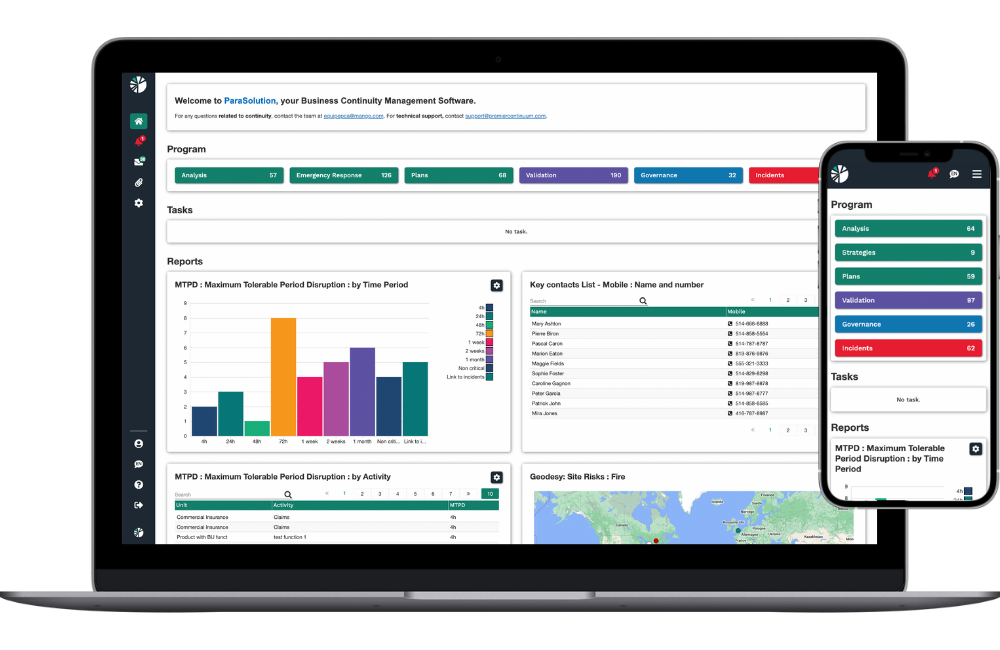Looking for a robust methodology for selecting an appropriate BCM solution? Info-Tech’s new BCM Software Selection Guide got you covered. Download it now, for free.
Why should you implement a Business Continuity Management Program?

Your BCMP is your organization's life jacket. One day, you might fall into the water, and it might be freezing, you might have to swim for hours until you reach the shores but, in the end, it will keep you afloat. You will survive.

First off, what is a Business Continuity Management Program?
A Business Continuity Management Program (BCMP) is defined as “an ongoing management and governance process supported by top management and appropriately resourced to implement and maintain business continuity management.” (Source: ISO 2300:2021).
Because your organization needs to keep rolling whatever incidents it faces, there is a lot to plan for.
That being said, business continuity helps you keep a sound management and develop efficient incident responses. While managing client expectations and validating your regulatory requirements, it also gives you a competitive edge now that you are ready for any eventuality.
To summarize, business continuity is way more than pieces of paper written in haste!
And as you can probably imagine, keeping tons of Word and Excel documents is not an efficient way to do it.
Dedicated to small as well as large organizations, here is your handbook on why you should implement a complete and thorough business continuity management program (BCMP).
5 reasons for implementing a Business Continuity Management Program (BCMP)

1. Centralization
When you develop a Business Continuity Management Program, you begin by collecting detailed information regarding your organization. The process will result in a compilation or centralization of all the data which provides many benefits such as clarity.
The centralization of all collected data makes it easier to grasp and globally visualize your current state; What is missing? What can be improved? What is working?
“Alive and Functional!”
If you don’t have a BCMP yet, be ready to hear this a lot. Even though it might not be the first thing that comes up in your mind when you think about business continuity, it is the most important recommendation. The same way your organization grows and evolves, your program must follow. Keeping it alive as well as nurturing its components through analysis, exercise, and maintenance, allow you to identify new opportunities and vulnerabilities.
And what about automated BCMP?
Now, let’s talk about automated business continuity solutions. The concept of Business Continuity itself is not very old (1970s only!), so it is to be expected that only a few software out there provide what you would need. Even though it’s not a requirement per se, automation is the virtual Taylorism of our sector. Data can be “stored” in the same place making it accessible and allowing for better analysis, decision-making,review but also reliability.
Premier Continuum's Business Continuity and Resilience consultants recognize the importance of BCMP automation. That's why we've been developing ParaSolution, our own BCM software since 2002, now acknowledged worldwide by Gartner, the Business Continuity Institute (BCI), and SoftwareReviews.

The approach offered by a software will, above all, optimize your activity and increase your efficiency.
Among other things, automation will support your BCMP throughout the whole BCM cycle (Policy and Program Management / Embedding / Analysis / Design / Implementation / Validation) and will give you the opportunity to view consolidated real-time data, required resources and have a better understanding of your organization context.


2. Compliance & Security
Implementing a Business Continuity Program is not always a matter of choice. Whether you need to comply with laws and regulatory requirements or meet vendors, partners and clients' demands, you might need to change your approach to business management.
When you implement a Business Continuity Program, and therefore a Business Continuity Plan, you reassure your vendors, partners and clients that you have the required actions to protect your business relation, your mutual interests and that your critical services will be maintained.
Did you know that 73.6% of organizations ask key suppliers (new/ existing) whether they have business continuity arrangements in place?
– Source: BCI Supply Chain Resilience Report, 2023
Being prepared as well as knowing your strategies, dependencies or required resources ease the worries that might emerge while establishing a business relationship.
The use of a software solution will support yourclaims and position in the industry. It allows your organization to developprocedures and policies in order to secure data and assets. As we know,information is a gold nowadays, which means that organizations want to ensurethat when they enter into a business relationship, all the data they’ll exchange will be protected.
Moreover, it can be interesting to pursue a certification or at least use the framework of standards such as ISO27001/SOC/NIST,etc. The list may be long, but the purpose is similar: information security. These standards refer and validate how the information security is managed and protected inside your organization.
ISO 22301, a certification for security and resilience - business continuity systems - requirements
Have you ever heard of ISO 22301? Among other things, this norm acts as a framework for managing business continuity in an organization. That being said, conforming to this certification will certainly help you ascertaining your compliance and security.
BCI's Horizon Scan Report 2021 even reveals that about 65 % of organizations are ISO 22301 certified or use it as a framework :

Centralized information, a way to pass through audits
Automation is also a must when it comes to evidence trail during audits. No matter the level of maturity of your organization, audits are always dreaded. That is the reason why automation comes in handy with centralized, reliable, and up-to-date information.
Find out more about the ISO certification here.

3. Scalability
As we saw previously, a business continuity management program must be alive and evolve just like your organization. Here enters the notion of scalability.
The good practices involve a regular review of the program or following significant changes. This ensures that your organization’s framework is accurate, that it fits your level of maturity, and that leadership is aware of relevant changes.
Implementing a BCMP comes back to building a framework for your organization, a set of guidelines designed to eliminate main roadblocks, keep track of what’s done and what needs to be done (e.g., Training and Awareness records). The process itself is streamlined and whether your teams and/or departments grow, program activities, like exercises, will still be easily done.
Two essential tools contributing to the scalability are Workflows and Gap Analysis :
Workflows
Accessible through a software, the Workflows help the organization to schedule the review, maintenance or update of the program. You will also be able to take it to the next level, by focusing on actions that add value and efficiently accelerate the completion of tasks.
Gap Analysis
On its end, the Gap Analysis is a must to evaluate the current state of Business Continuity in your organization. Combine it with a software and you’re unstoppable. Imagine, at a glance, you’d be able to see precisely where the gaps are and what can be done to fill them. That’s the power of automation.
When we talk about scalability, we also talk about the future. This global view, created by the BCMP, shows all the bridges, opportunities for optimization and certifications. There is no end to evolution but the limits that you set.

Recognize and acknowledge the process and the program
As previously mentioned, a BCMP implies the compilation of data. Therefore, during BIA/BCP interviews, business units will be asked to share the nature of their activities, the MTPD (Maximum Tolerable Period of Disruption), the RTO (Recovery Time Objective) and so on. They will also regularly participate in trainings and exercises to validate their solutions and state of preparedness. Maintaining the program contribute a better engagement throughout the organization.
Furthermore, since a BCMP requires discipline and organization, its elaboration can help you to optimize or to update your organizational structure. Indeed, your BCMP will help you identify the roles and responsibilities of every member of your organization, and help you reinforce relevant links and procedures. The advantage is that, when an unforeseen event occurs, the whole acts as a unified body

4. Reputation
Have you ever considered that potential clients may decide to choose an organization with a BCMP for security reasons, but also because they expect a certain level of professionalism? That your partners could also be more inclined in investing if they knew the organization has a strong BCMP to maintain its activities?
Last but not least, vendors have the power to decide to not go “all in” if they know you don’t have a program with solutions to mitigate losses.
"Implementing a BCMP can help organizations capture opportunities. ‘’
Whether you want to expand your client pool, establish partnerships, or secure contracts with vendors, a BCMP will always be favorably perceived. Adding a BCMP to your “deck” can also give you the opportunity to gauge the market and its trends (What are the requirements? What attracts clients? etc.).

A BCMP will help you identify where you’re exposed (e.g., frequent delays) and by doing so, it will guide you in designing contracts. You know what SLA (Service Level Agreement) terms are realistic.
However, it’s not only about knowing your organization, but also, about knowing with whom you do business. You should verify that your vendors have at least a BCP in place then, ensure that the solutions where your activities meet are reliable, via a Vendor risk assessment. Through a series a predetermined questions, you can assess the resilience of your vendors and develop new business relations.

5. Mobilization
To implement a business continuity program, you engage in many activities that will mobilize all levels of your organization.
The main component of a successful mobilization is to build a solid organizational culture through communication, and your number one target is Leadership.
‘’A strong engagement of the management team in the process contribute to the mobilization of other employees and the recognition of the discipline.’’
- Source: BCI Crisis Management Report 2021
Mobilization is a success factor when implementing a Business Continuity Management Program.
In fact, when top management is mobilized at key stages of the continuity program and offers a strategic vision and a strong commitment to the integration of good continuity practices, the rest of the organization is more inclined to integrate these practices at a tactical or even operational level.
Mobilization also involves raising awareness. This involves macro-level activities that bring employees together and are designed to be "formative". These range from notification tests to simulate an incident affecting the entire organization, to training courses on phishing and cybersecurity.
The aim will always be to ensure business continuity and maintain the organization's operational resilience.

Ready to start or to optimize your own business continuity management program?
In conclusion, implementing a Business Continuity Management Program goes far beyond ticking another boxcard. It’s what will differentiate you from the others, what will make you prepared to control impacts and stay in business.
If you need help regarding the implementation of your BCMP, feel free to contact our experts, who will guide you through every step.
About the author

Marion Escriu, CBCI, ISO 22301 Lead Auditor
Marion is a Business Continuity and Organizational Resilience Consultant at Premier Continuum. She assists clients on various mandates ranging from the establishment of a Business Continuity Program, to IT Disaster Recovery and to certification support.







